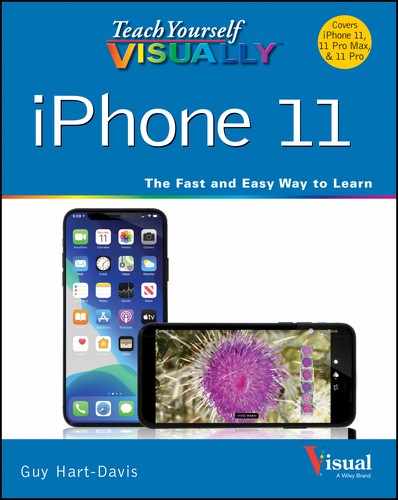CHAPTER 7
Working with Apps
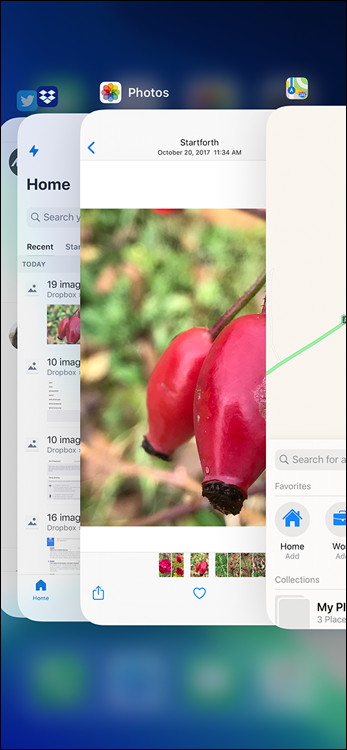
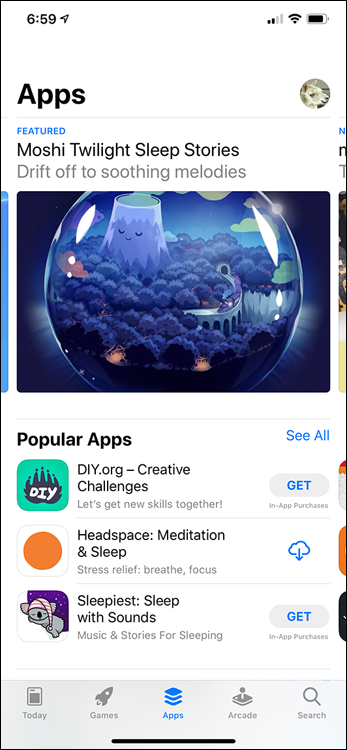
iOS enables you to customize the Home screen, putting the icons you need most right at hand and organizing them into folders. You can switch instantly among the apps you are running, find the apps you need on Apple’s App Store, and update and remove apps. You can also work easily with text and take notes.
Switch Quickly from One App to Another
Customize the Home Screen
From the Home screen, you run the apps on your iPhone. You can customize the Home screen to put the apps you use most frequently within easy reach. You can create additional Home screen pages as needed and move the app icons among them so that the app icons are arranged in the way you find fastest and most convenient to use.
Customize the Home Screen
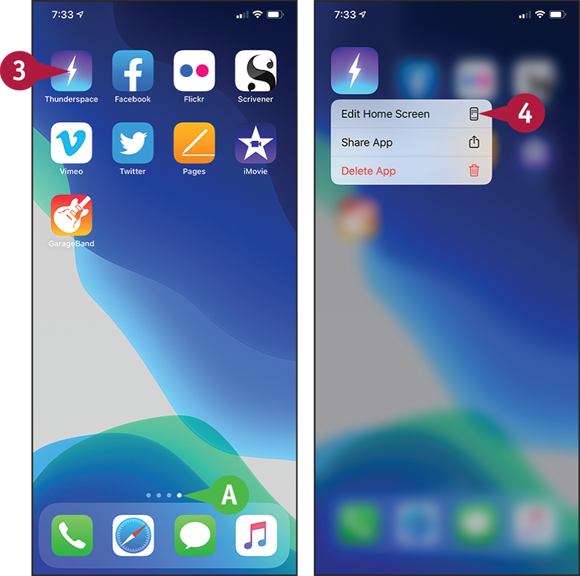
Unlock the Icons for Customization
![]() Swipe up from the bottom of the screen.
Swipe up from the bottom of the screen.
The Home screen appears.
![]() Swipe left or right to display the Home screen page you want to customize.
Swipe left or right to display the Home screen page you want to customize.
![]() You can also tap the dots, or to their left or right, to move from one page to the previous or next page.
You can also tap the dots, or to their left or right, to move from one page to the previous or next page.
![]() Tap and hold any app’s icon on that Home screen page.
Tap and hold any app’s icon on that Home screen page.
The pop-up menu opens.
![]() Tap Edit Home Screen (
Tap Edit Home Screen (![]() ).
).
The icons start to jiggle, indicating that you can move them.
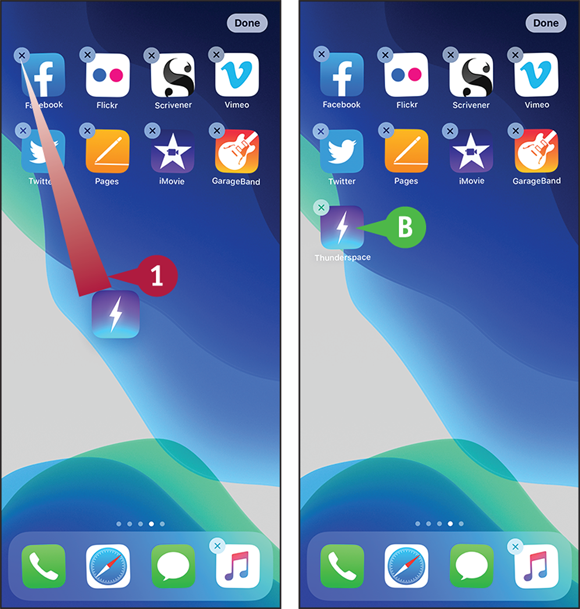
Move an Icon Within a Home Screen
![]() After unlocking the icons, drag the icon to where you want it.
After unlocking the icons, drag the icon to where you want it.
The other icons move out of the way.
![]() When the icon is in the right place, drop it.
When the icon is in the right place, drop it.
![]() The icon stays in its new position.
The icon stays in its new position.

Move an Icon to a Different Home Screen
![]() After unlocking the icons, drag the icon to the left edge of the screen to display the previous Home screen page or to the right edge to display the next page.
After unlocking the icons, drag the icon to the left edge of the screen to display the previous Home screen page or to the right edge to display the next page.
The previous page or next page appears.

![]() Drag the icon to where you want it.
Drag the icon to where you want it.
If the page contains other icons, they move out of the way as needed.
![]() Drop the icon.
Drop the icon.
![]() The icon stays in its new position.
The icon stays in its new position.
Stop Customizing the Home Screen
![]() Tap Done.
Tap Done.
The icons stop jiggling.
Organize Apps with Folders
To organize the Home screen pages, you can arrange the items into folders. The iPhone’s default Home screen layout includes a folder named Utilities, which contains items such as the Calculator app and the Compass app, but you can create as many other folders as you need. Like the Home screen, each folder can have multiple pages, with up to nine apps on each page, so you can put many apps in a folder.
Organize Apps with Folders

Create a Folder
![]() Display the Home screen page that contains the icon you want to put into a folder.
Display the Home screen page that contains the icon you want to put into a folder.
![]() Tap and hold an icon.
Tap and hold an icon.
The pop-up menu opens.
![]() Tap Edit Home Screen (
Tap Edit Home Screen (![]() ).
).
The icons start to jiggle, indicating that you can move them.
Note: When creating a folder, you may find it easiest to first put both items you will add to the folder on the same page.
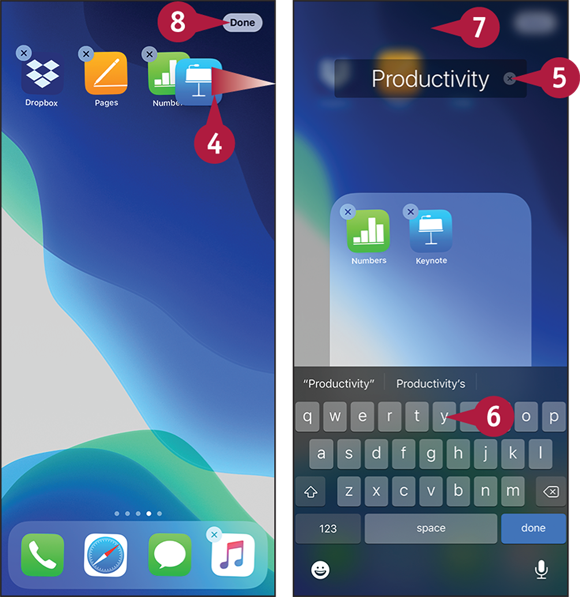
![]() Drag the icon to the other icon you want to place in the folder you create.
Drag the icon to the other icon you want to place in the folder you create.
The iPhone creates a folder, puts both icons in it, and assigns a default name based on the genre, if it can identify a genre.
![]() Tap Delete (
Tap Delete (![]() ) to delete the folder name.
) to delete the folder name.
The keyboard appears.
![]() Type the new name for the folder.
Type the new name for the folder.
![]() Tap outside the folder.
Tap outside the folder.
The iPhone applies the name to the folder.
![]() Tap Done.
Tap Done.
The icons stop jiggling.
Note: You can quickly rename a folder by pressing it, tapping Rename, typing the new name, and then tapping outside the folder.
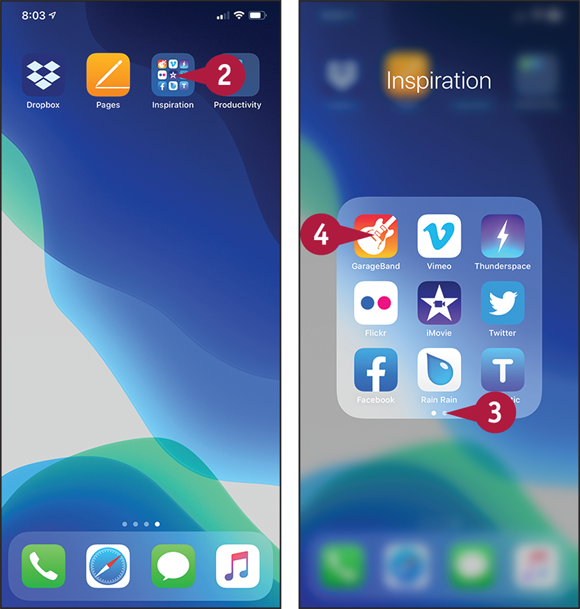
Open an Item in a Folder
![]() Display the Home screen page that contains the folder.
Display the Home screen page that contains the folder.
![]() Tap the folder’s icon.
Tap the folder’s icon.
The folder’s contents appear, and the items outside the folder fade and blur.
![]() If necessary, swipe left or right or tap to the left or right of the dots to navigate to another page in the folder.
If necessary, swipe left or right or tap to the left or right of the dots to navigate to another page in the folder.
![]() Tap the item you want to open.
Tap the item you want to open.
The item opens.

Add an Item to a Folder
![]() Display the Home screen page that contains the item.
Display the Home screen page that contains the item.
![]() Tap and hold an icon.
Tap and hold an icon.
The pop-up menu opens.
![]() Tap Edit Home Screen (
Tap Edit Home Screen (![]() ).
).
The icons start to jiggle, indicating that you can move them.
![]() Drag the icon on top of the folder and drop it there.
Drag the icon on top of the folder and drop it there.
Note: If the folder is on a different Home screen page from the icon, drag the icon to the left edge to display the previous page or to the right edge to display the next page.
The item goes into the folder.
![]() Tap Done to stop the icons jiggling.
Tap Done to stop the icons jiggling.
Switch Quickly from One App to Another
You can run many apps on your iPhone at the same time, switching from one app to another as needed.
You can switch apps by displaying the Home screen and then tapping the icon for the next app. But the iPhone also has an app-switching screen that enables you to switch quickly from one running app to another running app. From the app-switching screen, you can also easily close one or more running apps.
Switch Quickly from One App to Another
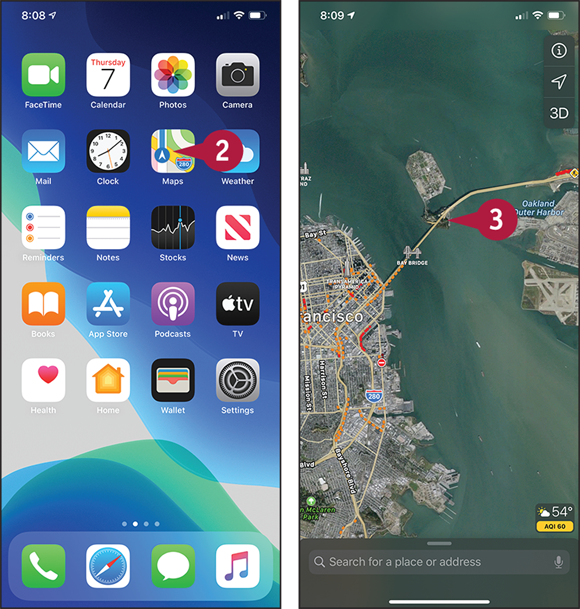
![]() Swipe up from the bottom of the screen.
Swipe up from the bottom of the screen.
The Home screen appears.
![]() Tap the app you want to launch. This example uses Maps (
Tap the app you want to launch. This example uses Maps (![]() ).
).
The app’s screen appears.
![]() Start using the app as usual.
Start using the app as usual.
Note: You can also switch quickly from one app to another by swiping left or right on the invisible bar at the bottom of the screen.

![]() Swipe up from the bottom of the screen to the middle, and then pause momentarily.
Swipe up from the bottom of the screen to the middle, and then pause momentarily.
![]() The app-switching screen appears, showing a carousel of thumbnails of the open apps.
The app-switching screen appears, showing a carousel of thumbnails of the open apps.
![]() The icons identify the app thumbnails.
The icons identify the app thumbnails.
![]() Swipe left or right to scroll until you see the app you want.
Swipe left or right to scroll until you see the app you want.
Note: The last app you used appears on the right side of the app-switching screen. To its right is the Home screen. To its left are the apps you have used most recently.
![]() Tap the app.
Tap the app.

The app appears.
![]() When you are ready to switch back, display the app-switching screen again. Swipe up from the bottom of the screen to the middle, and then pause momentarily.
When you are ready to switch back, display the app-switching screen again. Swipe up from the bottom of the screen to the middle, and then pause momentarily.
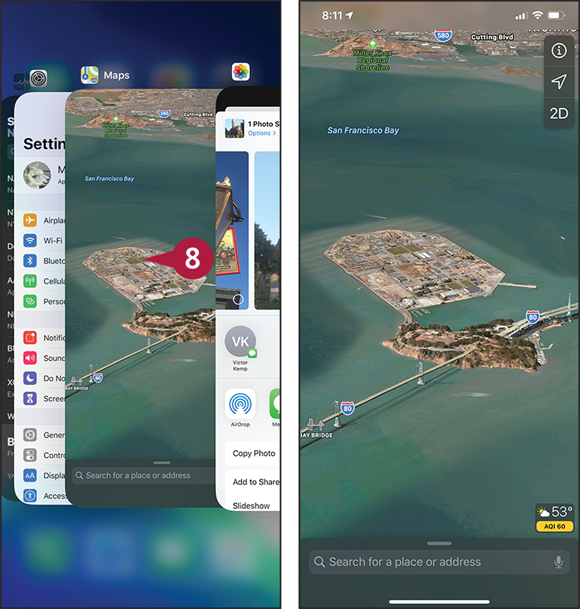
![]() Scroll left or right as needed, and then tap the app to which you want to return.
Scroll left or right as needed, and then tap the app to which you want to return.
The app appears, ready to resume from where you stopped using it.
Find Apps on the App Store
The iPhone comes with essential apps, such as Safari for surfing the web, Mail for e-mail, and Calendar for keeping track of your schedule. But to get the most out of your iPhone, you will likely need to add other apps.
To get apps, you use the App Store, which provides apps that Apple has approved as correctly programmed, suitable for purpose, and free of malevolent code. Before you can download any apps, including free apps, you must create an App Store account.
Find Apps on the App Store
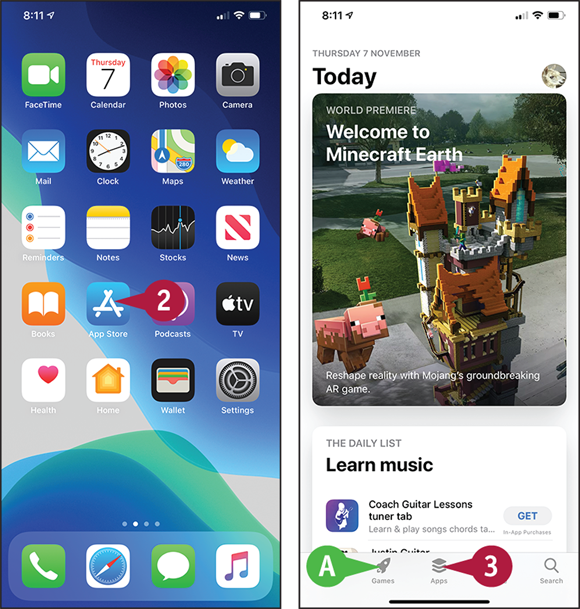
![]() Swipe up from the bottom of the screen.
Swipe up from the bottom of the screen.
The Home screen appears.
![]() Tap App Store (
Tap App Store (![]() ).
).
The App Store screen appears.
Usually, the Today screen appears at first.
![]() Tap Apps (
Tap Apps (![]() changes to
changes to ![]() ).
).
![]() You can tap Games (
You can tap Games (![]() changes to
changes to ![]() ) if you want to browse games instead of apps.
) if you want to browse games instead of apps.
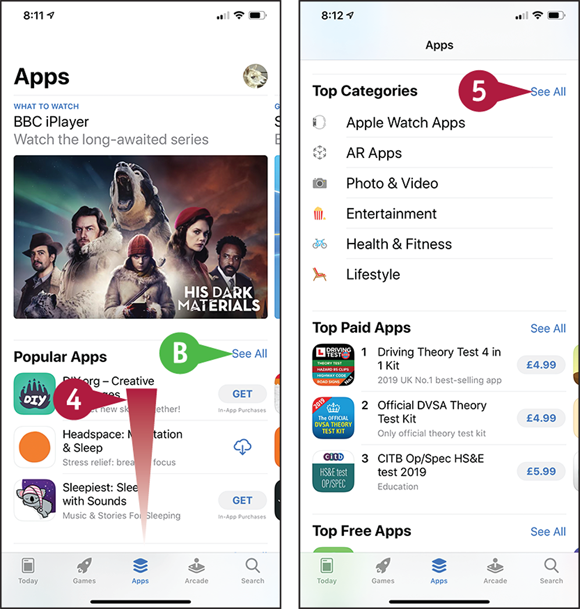
The Apps screen appears.
![]() You can tap See All for a list to see the whole list.
You can tap See All for a list to see the whole list.
![]() Swipe up to scroll down until the Top Categories section appears.
Swipe up to scroll down until the Top Categories section appears.
Note: The Top Free Apps list shows the free apps that App Store users are downloading. The Top Paid Apps list shows the apps that App Store users are buying.
![]() Tap See All in the Top Categories section.
Tap See All in the Top Categories section.

The Categories screen appears.
![]() Tap the category you want to see. This example uses the Business category.
Tap the category you want to see. This example uses the Business category.
The category’s screen appears.
![]() You can tap See All to view the full list.
You can tap See All to view the full list.
![]() Tap the app you want to view.
Tap the app you want to view.
Note: To understand what an app does and how well it does it, look at the app’s rating, read the description, and read the user reviews. Swipe the images to see screen captures from the app.
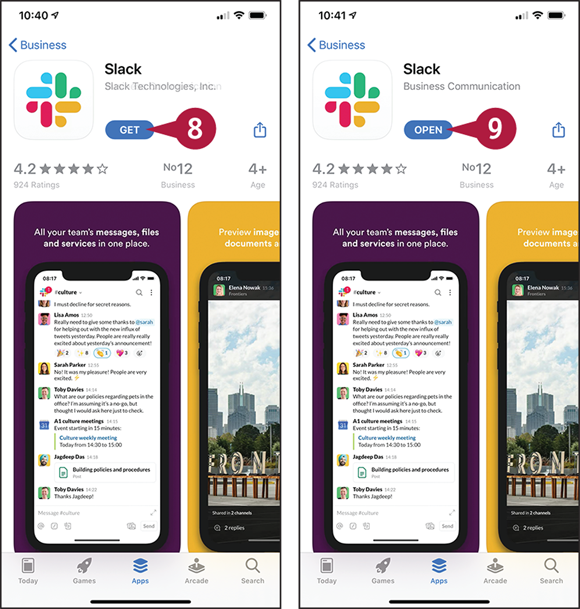
The app’s screen appears.
![]() Tap the price button or the Get button.
Tap the price button or the Get button.
Note: If the iPhone prompts you to sign in, type your password and then tap OK.
Note: If you have not created an App Store account already, the iPhone prompts you to create one now.
The iPhone downloads and installs the app.
![]() Tap Open.
Tap Open.
Note: If you switch to another app while the new app downloads and installs, launch the new app from the Home screen instead.
The app opens, and you can start using it.
Update and Remove Apps
To keep your iPhone’s apps running smoothly, you should install app updates when they become available. Most minor updates for paid apps are free, but you must often pay to upgrade to a new version of the app.
When you no longer need an app you have installed on your iPhone, you can remove it, thus recovering the space it occupied. You can remove some but not all of the built-in apps.
Update and Remove Apps

Update One or More Apps
![]() Swipe up from the bottom of the screen.
Swipe up from the bottom of the screen.
The Home screen appears.
![]() The badge on the App Store icon shows the number of available updates.
The badge on the App Store icon shows the number of available updates.
![]() Tap App Store (
Tap App Store (![]() ).
).
The App Store screen appears.
![]() Tap Account (
Tap Account (![]() or your chosen picture).
or your chosen picture).
Note: You can go straight to the Updates screen by tapping and holding App Store (![]() ) on the Home screen and then tapping Updates (
) on the Home screen and then tapping Updates (![]() ) on the pop-up panel.
) on the pop-up panel.
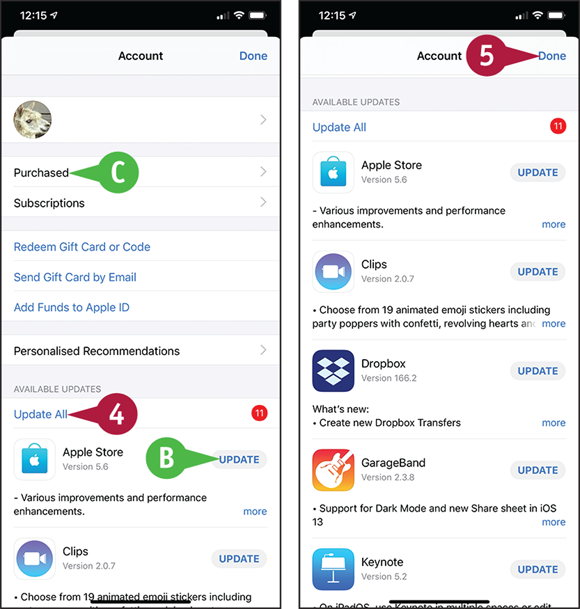
The Updates screen appears.
![]() Tap Update All to apply all the available updates now.
Tap Update All to apply all the available updates now.
![]() You can tap Update to update a single app.
You can tap Update to update a single app.
![]() You can tap Purchased to display the Purchased screen, from which you can install apps you have bought previously but not yet installed on this iPhone.
You can tap Purchased to display the Purchased screen, from which you can install apps you have bought previously but not yet installed on this iPhone.
![]() Tap Done.
Tap Done.

Remove an App from the iPhone
![]() Swipe up from the bottom of the screen.
Swipe up from the bottom of the screen.
The Home screen appears.
![]() Display the Home screen that contains the app you want to delete.
Display the Home screen that contains the app you want to delete.
![]() Tap and hold the app you want to delete.
Tap and hold the app you want to delete.
The pop-up menu appears.
![]() Tap Delete App (
Tap Delete App (![]() ).
).
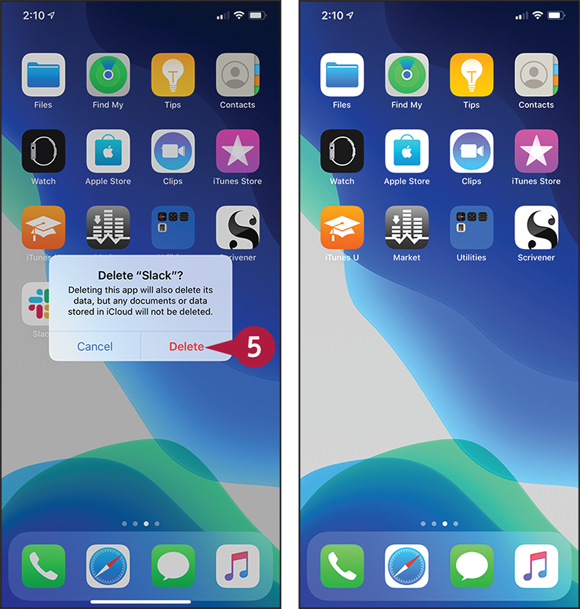
The Delete dialog appears.
![]() Tap Delete.
Tap Delete.
The iPhone deletes the app, and the app’s icon disappears.
Type, Cut, Copy, and Paste Text
You can easily type text on your iPhone’s keyboard, either by tapping each letter or by sliding your finger from letter to letter, using the QuickPath feature; you can also dictate text using Siri. If the text already exists, you can copy and paste it instead.
If the text is in a document you can edit, you can either copy the text or cut it. If the text is in a document you cannot edit, you can only copy the text.
Type, Cut, Copy, and Paste Text

Type Text
![]() Open an app that supports text entry. To follow this example, tap Notes (
Open an app that supports text entry. To follow this example, tap Notes (![]() ) on the Home screen, and then tap New (
) on the Home screen, and then tap New (![]() ) to start a new note.
) to start a new note.
![]() Type a word by placing your finger on the first letter and then sliding it to each successive letter. Lift your finger off the screen when the word is complete.
Type a word by placing your finger on the first letter and then sliding it to each successive letter. Lift your finger off the screen when the word is complete.
![]() If the suggestion bar shows the word you want, tap it to enter it.
If the suggestion bar shows the word you want, tap it to enter it.
![]() Type a word by tapping each letter in turn.
Type a word by tapping each letter in turn.
![]() Press return to create a new line.
Press return to create a new line.
![]() Type some more text to use for the copy-and-paste example.
Type some more text to use for the copy-and-paste example.
Copy Text

![]() Tap and hold a word in the section of text you want to copy or cut.
Tap and hold a word in the section of text you want to copy or cut.
The word becomes highlighted.
![]() Selection handles appear around the selection.
Selection handles appear around the selection.
![]() The formatting bar appears.
The formatting bar appears.
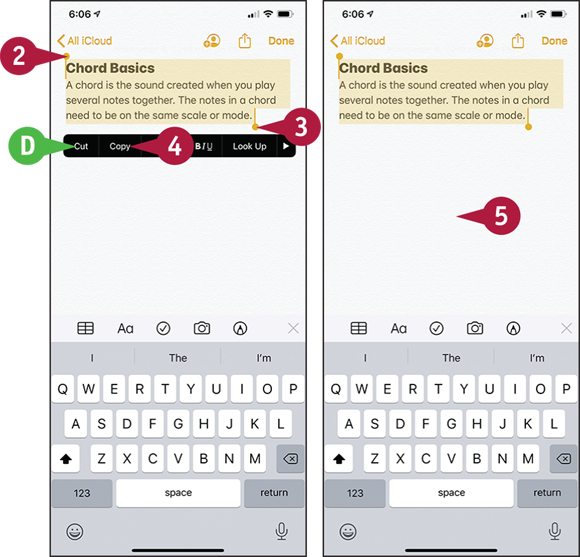
![]() Drag the start handle (
Drag the start handle (![]() ) to the beginning of the text you want.
) to the beginning of the text you want.
![]() Drag the end handle (
Drag the end handle (![]() ) to the end of the text you want.
) to the end of the text you want.
![]() Tap Copy.
Tap Copy.
![]() You can tap Cut if you want to remove the selected text from the document.
You can tap Cut if you want to remove the selected text from the document.
The formatting bar disappears.
Your iPhone places the text on the Clipboard, a hidden storage area.
![]() If you no longer need the text to be selected, tap outside the text to deselect it.
If you no longer need the text to be selected, tap outside the text to deselect it.
Paste the Content You Have Copied or Cut
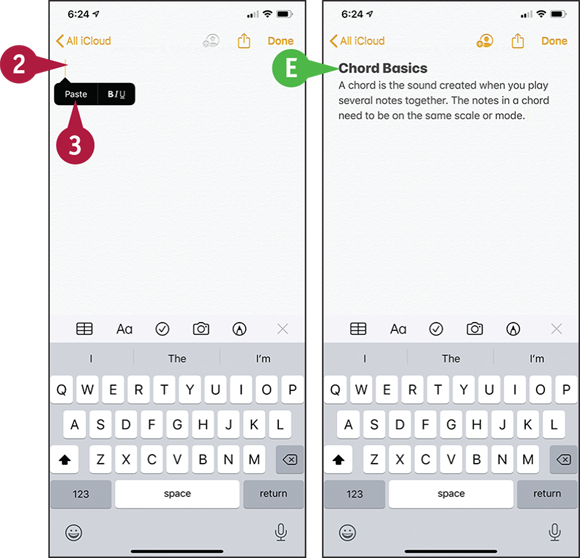
![]() Open the app and document into which you want to paste the text. This example uses a new note in the Notes app.
Open the app and document into which you want to paste the text. This example uses a new note in the Notes app.
![]() Tap where you want to paste the text.
Tap where you want to paste the text.
The formatting bar appears.
![]() Tap Paste.
Tap Paste.
![]() The pasted text appears in the document.
The pasted text appears in the document.
Format and Replace Text
Some apps enable you to add text formatting such as boldface, underline, or italics to text to make parts of it stand out. For example, you can apply formatting in e-mail messages you create using the Mail app on some e-mail services and in various apps for creating word-processing documents.
To apply formatting, you first select the text, and then choose options from the pop-up formatting bar. Some apps also offer other text commands, such as replacing a word or phrase from a menu of suggestions.
Format and Replace Text
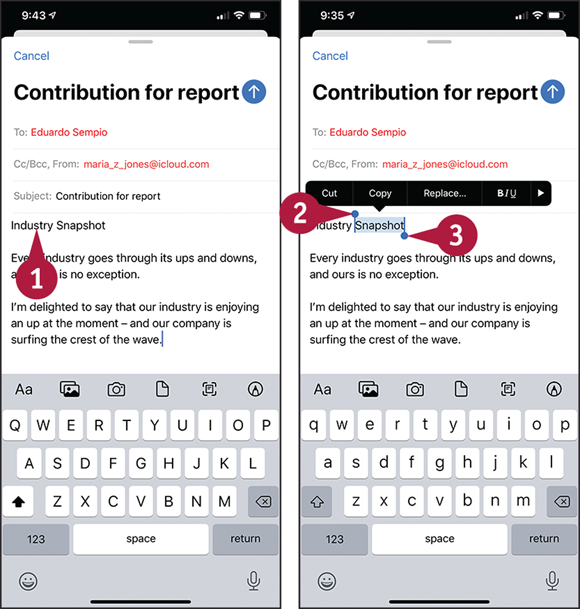
Apply Bold, Italics, or Underline
![]() Tap and hold the text to which you want to apply bold, italics, or underline.
Tap and hold the text to which you want to apply bold, italics, or underline.
Part of the text becomes highlighted, and the selection handles appear.
The formatting bar appears.
![]() Drag the start handle (
Drag the start handle (![]() ) to the beginning of the text you want.
) to the beginning of the text you want.
![]() Drag the end handle (
Drag the end handle (![]() ) to the end of the text you want.
) to the end of the text you want.
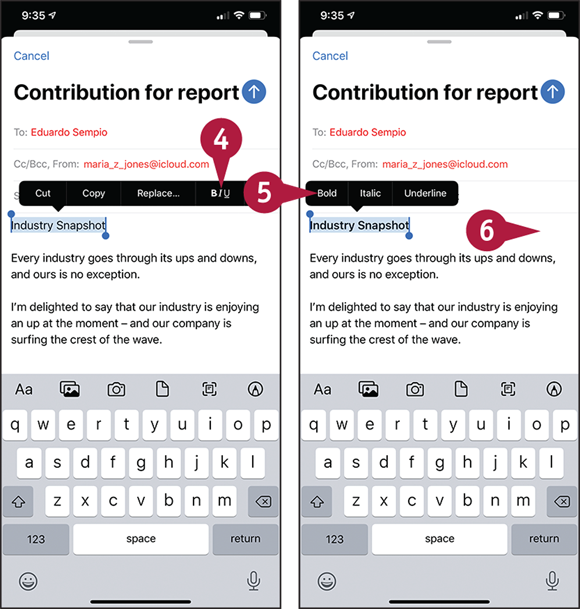
![]() Tap BIU on the formatting bar.
Tap BIU on the formatting bar.
The formatting bar displays formatting options.
![]() Tap Bold, Italic, or Underline, as needed.
Tap Bold, Italic, or Underline, as needed.
The text takes on the formatting you chose.
![]() Tap outside the selected text to deselect it.
Tap outside the selected text to deselect it.
Note: Some apps have their own formatting tools, many of which are more extensive than the standard formatting tools shown here.
Note: Some e-mail services and notes services do not support formatting.
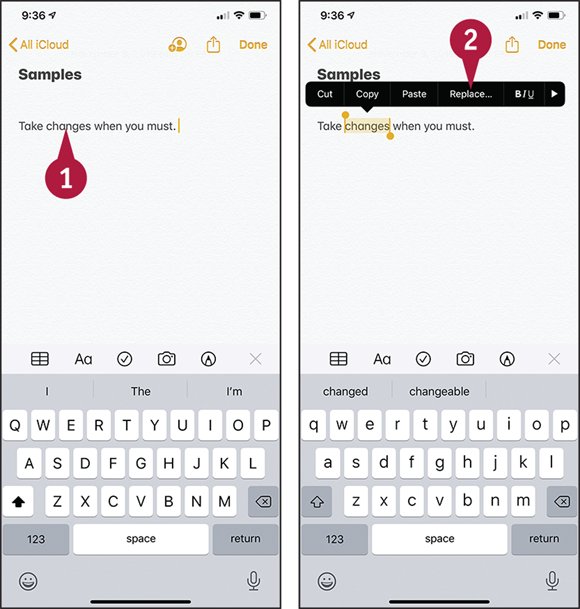
Replace Text with Suggested Words
![]() Double-tap the word you want to replace.
Double-tap the word you want to replace.
The word becomes highlighted and selection handles appear around it.
The formatting bar appears.
![]() Tap Replace.
Tap Replace.
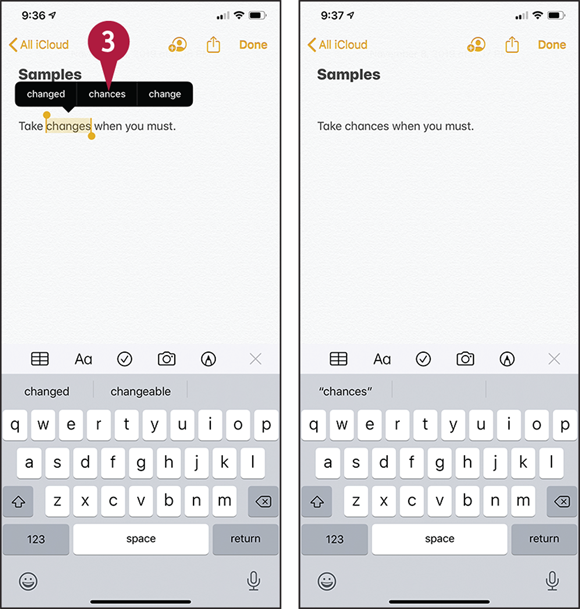
The formatting bar displays suggested replacement words.
![]() Tap the word with which you want to replace the selected word.
Tap the word with which you want to replace the selected word.
The word you tapped appears in the text.
Note: Tap More (![]() ) to display more commands on the formatting bar. For example, in some apps, you can insert photos and videos.
) to display more commands on the formatting bar. For example, in some apps, you can insert photos and videos.
